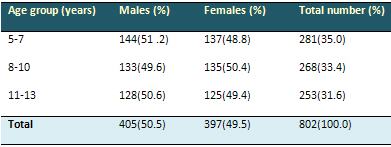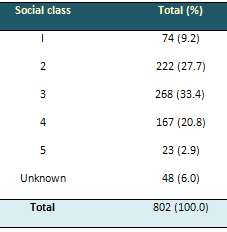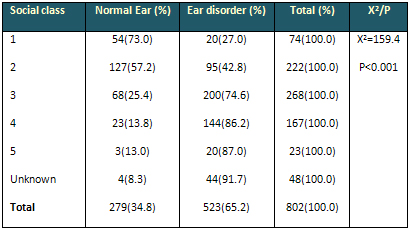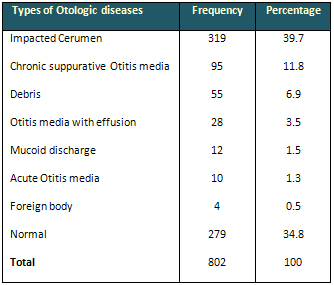|
Prevention of
Otologic disorders in Nigeria: The Case of Primary
School Children in Rivers State, South South of
Nigeria
......................................................................................................................................................................
Nduka, Ijeoma (1)
Enwereji, Ezinna Ezinne (2)
Aitafo, Josephine Enekole (3)
(1) Nduka, Ijeoma, Department
of Community Medicine,
Niger Delta University Wilberforce Island,
Amassoma Bayelsa state, Nigeria.
(2) Enwereji, Ezinna Ezinne, College of Medicine,
University Teaching Hospital,
Abia State University Uturu, Aba, Abia State,
Nigeria.
(3) Aitafo, Josephine Enekole
Braithwaite Memorial Specialist Hospital,
6, Haley Street, Off Forces Avenue, Old GRA,
Port Harcourt, Rivers State
Correspondence:
Enwereji, Ezinna Ezinne, College of Medicine,
University Teaching Hospital ,
Abia State University Uturu, Aba,
Abia State, Nigeria.
Email: hersng@yahoo.com
|
ABSTRACT
Introduction: Common ear diseases
in children are preventable. In developing
countries like Nigeria, most health care
programmes concentrate on secondary school
pupils to the disadvantage of those in primary
schools. This has delayed reduction of preventable
ear diseases. Ear diseases among children
can lead to disabilities especially permanent
hearing loss. The question is to what extent
are otologic disorders prevented among primary
school children? The researchers carried
out school health programmes to identify
common ear diseases in primary school children
so as to contribute a quota in prevention
of otologic diseases among them.
Materials and method: This was a
cross-sectional descriptive study. Random
sample of 1,200 pupils from primary 1-6
between 5 to 13 years were selected for
study from 13 primary schools. Only 802
pupils whose parents gave consent eventually
participated in this study. Administered
semi-structured questionnaire was used to
obtain information on participants from
parents. Also, otoscopic examination of
respondents was carried out by the researchers
after being trained in use of otoscope by
a specialist. Complete physical examination
of the 802 children was done. Cerumen was
recorded if no part of tympanic membrane
was visible.
Thereafter, cerumen, other debris and foreign
bodies were removed in such children. External
canals and tympanic membranes were inspected
for likely abnormalities. Data analyses
were done using SPSS version
17.0 statistical software. Results were
presented on tables using frequency and
percentages.
Results: Findings showed that out
of 802 children studied, only 279(34.8%)
were found normal.
The common Otologic diseases found among
the respondents were impacted cerumen 319(39.7%),
chronic suppurative otitis media 95 (11.8%),
debris 55 (6.9%), Otitis media with effusion
28 (3.5%), and acute otitis media 10 (1.3%).
Conclusion: Based on the proportion
of children identified with otologic problems,
there is need for periodic and well coordinated
school health programmes.
Key words: Otologic
disorders, school children, otitis media,
hyperemic.
|
The importance of prevention
of ear diseases as an organ of hearing cannot
be overemphasized. Disorders of the ear among
children in developing countries have been widely
reported as a major public health problem [1-6].
Delayed speech, cognitive, emotional, social and
academic developments have been reported as some
of the direct effects of hearing impairment in
children [7].Studies have shown that a good proportion
of children with ear diseases have difficulties
in learning and as a result, their academic performances
are negatively affected [8,9]. It is a well known
fact that with early medical intervention, disability
from diseases of the ear can be prevented. However,
most times children with ear problems are not
diagnosed early and as a result, the diseases
progress to profound deafness.
Ear disorders in children can arise from congenital
problems such as Crouzons's disease, Down's syndrome,
Achondroplasia or Marfan's disease and others
[10-12]. Ear disorders in children can also result
from acquired causes like otitis media with effusion
(OME), otitis externa, trauma leading to perforation
of the tympanic membrane or impacted cerumen [13,14].
There have been various views regarding the effect
of removing impacted cerumen (wax). Some researchers
argue that removing impacted cerumen (wax) prevents
hearing loss [15,16], while others emphasize that
there will be persistent hearing loss even after
the wax has been removed [17].
Studies have recommended a high index of suspicion
in the diagnosis of ear diseases among children.
This is necessary because most studies are of
the view that Otitis media constitute the main
ear disorder in children living in developing
countries including Nigeria [18-20]. Some authors
further argue that most ear disorders present
with or without symptoms and that only a thorough
history and physical examination of children with
ear problems would guarantee effective diagnosis,
treatment and prevention of disability. Such authors
recommended that physicians should conduct thorough
examination of the head and neck area of a child
for a possible predisposing factors to developing
ear diseases when a history of high grade fever,
pain in the ear, ear discharge, pre or post auricular
swelling, hearing impairment, deep seated headache,
dizziness, tinnitus and vertigo is reported [21-25].
WHO (2000) recommended that periodic screening
for hearing impairments in schools will ensure
early diagnosis and treatment for children with
ear diseases especially those in developing countries.
This is necessary because some ear diseases are
gradual in onset, painless, without signs and
symptoms and at times invisible (26). Therefore,
without routine screening of school children especially
in places where there is no working national guidelines,
the likelihood of detecting children with ear
disorders could go unnoticed until later in the
child's age when prevention becomes difficult
[27-29]. In developed countries, where neonates
were screened for diseases of the ear, studies
have reported a high proportion of neonates with
hearing impairment [30]. Prevention of ear diseases
in children requires follow-up for the purposes
of repeat audiology test and for intervention
after definitive diagnoses (31,32).
The benefits of screening school children for
disabilities especially hearing loss should not
be underestimated. In developing countries, like
Nigeria, children with disabilities are totally
dependent on others and as such, have little or
no contribution towards the economic development
of the country where they reside. The need to
ensure that youths live satisfying and fulfilled
lives devoid of disabilities and dependence motivated
the researchers to conduct this study. This research
enabled the researchers to contribute a quota
to the recent call for the prevention of disabilities
among school children in Nigeria. In this study,
the researchers emphasized the need to strengthen
routine ear screening from neonatal period to
school period, periodic physical examinations
and health education in schools. The study will
help to complement the limited studies on childhood
ear diseases in Nigeria.
This cross-sectional descriptive
study was carried out to identify common otologic
disorders among primary school children in Rivers
State. The sample was made up 1,200 pupils in
primary 1-6 within the ages of 5 to 13 years randomly
selected from 13 primary schools. This study was
conducted in Port-Harcourt City (PHC). Port-Harcourt
was chosen for the study because it is the capital
of Rivers State and the major oil-producing State
in Nigeria. It attracts lots of investors and
tourists from all parts of the country and beyond.
Moreover, Port-Harcourt has the largest number
of highly populated primary schools among the
23 local governments in the State and therefore
afforded enough sample for the study. The thirteen
(13) schools selected for study were based on
the fact that their populations were made up of
both boys and girls (co-educational). The sample
size was calculated at a 95% confidence level
for a 13.9% proportion of hearing loss among primary
school children in Lagos, Nigeria [20]. To get
the sample for study, simple random sampling by
balloting was used to select 1200 pupils from
classes 1-6. Only 802 pupils whose parents gave
consent eventually participated in this study.
Semi-structured self administered questionnaire
was used to obtain information on the participants
from the parents. Also questionnaire was used
to explore the social status of the parents of
the respondents. The social status of the respondents'
parents was graded into five ( 1-5) categories
based on their monthly income. In addition, otoscopic
examination of the respondents was carried out
by the researchers after being trained on the
use of otoscope by a specialist. Also, complete
physical examination on the 802 children was done
and cerumen was recorded if no part of the tympanic
membrane was visible. Thereafter, cerumen, other
debris and foreign bodies were removed in such
children. The external canals and tympanic membranes
were later inspected for likely abnormalities.
Children were classified as having abnormal ear
drums or having otitis media if the drums were
perforated, hyperemic, retracted or showed evidence
of scarring with or without fluids. Data analyses
were done using SPSS version 17.0 [21] statistical
software. Results were presented in tables using
frequency and percentages.
Ethical consideration
Ethical clearance was obtained from the Ethics
Committee of the University of Port Harcourt Teaching
Hospital. The consents of the Director Rivers
State Ministry of Education, the head teachers
in the 13 schools, and parent of the pupils selected
for study were obtained. Their permissions enabled
the researchers to commence the study. Only the
children whose parents gave consent were included
for study.
Limitations to the study
The population studied was school children therefore,
the observed prevalence of ear diseases w ould
not reflect the actual picture in the general
population because institutional based study may
not give a clear picture of the situation outside
the school.. Also children not in school as well
as those whose parents refused to consent to the
study might have epidemiological characteristics
different from those who took part in the study.
The cross-sectional descriptive design of the
study could not allow causality to be determined.
The mean age of the respondents
was 8.6 years ± 2.3 years with median 8.0
years. About 405(50.5%) males and 397(49.5%) females
were studied. The age of the respondents was evenly
distributed. About 281 (35.0%) pupils were between
the age of 5-7 years and 253 (31.6%) were between
11-13 years. See Table 1 for more details As contained
in Table 2, the social class of the parents of
the study group was classified into 5 categories
using their monthly income. Those in category
1 were on monthly income of USD 2890, category
2, USD 2312, category 3 on USD 1692, category
4 on USD 867 and category 5 were on USD 289. The
social status of 48(6.0%) of the respondents ,
could not be ascertained because enough information
was not provided by their parents/guardians. Study
showed that a good proportion of the respondents
268 (33.4%) came from social class category 3.
The social class of the parents of the respondents
who had more otologic disorders than others was
noted. From the result of the study, respondents
from social status category 5 had the highest
incidence of otologic disorders. This is statistically
significant P<0.001 see Table 3 for more details.
The types of otologic diseases seen among the
respondents were noted. From the findings, impacted
cerumen 319(39.7%), Chronic suppurative otitis
media 95(11.8%), debris 55(6.9%), Otitis media
with effusion 28(3.5%), and acute otitis media
10(1.3%) were noted. See Table 4 for more details.
Table 1: Age and Sex Distribution of Study Population

Table 2: Social Class of the Study Population

Table 3: Social status of the parents of respondents
and Otologic disorders

Table 4: Respondents and types of Otologic
diseases noted

From the result of this study,
several otologic diseases were identified among
the respondents after the otologic examination.
The most common otologic diseases was impacted
cerumen. The fact that impacted cerumen was the
most common otologic disease among the population
studied showed the extent to which the tympanic
membranes of the respondents were occluded as
well as the extent they are exposed to hearing
loss. Impacted cerumen occluding the tympanic
membrane has been widely reported by several researchers
as the major cause of hearing loss in children
[12, 26]. This finding is similar to studies conducted
in other parts of Nigeria [20, 23], Turkey [24]
and Swaziland [25] where impacted cerumen was
identified as the main otologic disease among
the population studied. Usually impacted cerumen
in children is asymptomatic and can easily be
missed by parents and caregivers. This could possibly
lead to hearing impairment in the affected children.
Identifying foreign bodies as the least otologic
disease among the respondents (0.5%) is comparable
to that identified by some other studies [26,
27]. It is not surprising that foreign bodies
constitute the least otologic disease among the
group studied. This is because foreign bodies
usually present some discomforting symptoms that
will demand immediate attention for their removal.
Chronic suppurative otitis media (CSOM) has been
implicated as the major risk factor for ear diseases
in children [28]. It has been seen as the major
health challenge in several parts of the world
[22, 28, 29 ]. The finding in this study reveals
a CSOM prevalence of 11.8%. This is low compared
to a study conducted by Akinpelu etal [30] in
which a prevalence as high as 33.9% was seen among
the population studied. This high prevalence noted
in the previous studies could be attributed to
the wider age group interval (6months to 18years)
that participated in the study
as against the present study which used (5years
to 13 years).
Social status was an important
factor in the occurrence of otologic diseases
among the group studied. The lower the respondents'
social status the more otologic diseases they
presented with. In this study, chronic suppurative
otitis media was high among social status categories
4 and 5 which had monthly income of USD 867 and
USD 289 respectively. Chronic suppurative otitis
media has been linked to poor hygiene, nutrition,
and housing conditions and these poor conditions
encourage viral and bacterial infections [29].
This finding is comparable to previous studies
which found higher prevalence of chronic suppurative
otitis media among African-Americans than Caucasians
[31]. This difference in the prevalence was attributed
to poor standard of living among African-Americans.
Most individuals in the low socio-economic class
avoid living in places where they will be expected
to pay high house rent and as a result, they tend
to prefer living in suburbs where house rents
are low but the environmental conditions are poor.
The fact that the respondents from the lowest
social status categories 4 and 5, whose monthly
income was poor presented with more otologic problems
than others, showed that low social status constitutes
a major risk factor for otologic diseases among
school children. The prevalence of otologic diseases
of 65.2% among school children as identified in
this study, is lower than that reported by other
researchers in a study conducted in Nepal where
a prevalence of 75.7% was noted [22]. The observed
difference in the two studies conducted could
be influenced by the socio-demographic variations
in the two populations studied.
In ranking the prevalence of acute otitis media
(AOM) among the respondents, AOM with 1.3% was
the sixth otologic disorder. This ranking is comparable
to a study conducted in Nepal [22 ] in which AOM
with 1.4% prevalence was ranked as the 4th otologic
disorder seen among the group studied. In another
study [32] the prevalence of AOM was 28% and ranked
higher than the two studies above. The difference
in this ranking might be in the population studied.
The sample studied here comprised children with
febrile illnesses. AOM is an acute illness that
commonly presents with other febrile illnesses
in children [8]. Most often, in developing countries
where malaria is endemic, children who present
with feverish conditions with no other symptoms
suggestive of any ear disease are treated for
malaria, thereby making clinicians miss AOM, except
if the clinician has a high index of suspicion
for ear disorders and this often will lead to
further delay in making the diagnosis. The fact
that some ear diseases are asymptomatic and could
be missed or given late diagnosis when prevention
may be unattainable, periodic physical examination
as well as health education is needed in primary
schools.
Since cerumen impaction which was associated with
low social status and poor environmental condition
was the commonest otologic problem seen in this
study , the need to prevent it by routine examination,
aural toileting or simple cleaning with cotton
buds to check reaccumulation is necessary. Parents,
care givers, and teachers should be health educated
on how to identify symptoms for ear diseases in
children. During health programmes in school,
clinicians should examine every child's ear for
a possible ear disease.
1. Eisenberg, L. S. . Johnson, K. C Martinez, A.
S. Visser- Dumont, L. Ganguly, D. H. and J. F. Still,
"Studies in pediatric hearing loss at the House
Research Institute," Journal of the American
Academy of Audiology, vol. 23, no. 6, pp. 412-421,2012.
2. Islam, M. A. Islam, M. S.
. Sattar, M. A and M. I. Ali, "Prevalence
and pattern of hearing loss," Medicine Today,
vol. 23, no. 1, pp. 18-21, 2012.
3. Sekhar, D. L Zalewski, T.
R. and I. M. Paul, "Variability of state
school-based hearing screening protocols in the
United States,"Journal of Community Health,
vol. 38, no. 3, pp. 569-574, 2013.
4. Byrne, D. C Themann, C. L.
Meinke, . D. K Morata, T. C. and M. R. Stephenson,
"Promoting hearing loss prevention in audiology
practice," Perspectives on Public Health
Issues Related to Hearing and Balance, vol. 13,
no. 1, pp. 3-19, 2012.
5. Uller, R. M¨G. Fleischer,
and J. Schneider, "Pure-tone auditory threshold
in school children," European Archives of
Oto-Rhino- Laryngology, vol. 269, no. 1, pp. 93-100,
2012.
6. Turton,L and P. Smith, "Prevalence &
characteristics of severe and profound hearing
loss in adults in a UK National Health Service
clinic," International Journal of Audiology,
vol. 52, no. 2, pp. 92-97, 2013.
7. Gell FM, White E, McNewell
K, Mackenzie I, Smith A, Thompson S et al. Practical
screening priorities for hearing impairment among
children in developing countries. Bull.
World Health Org. 1992, 70:645-55.
8. Hadda J. Hearing loss In:
Behrman RE, Kliegman RM, Jenson BH. Eds. Nelson
Textbook of Paediatrics, 17th ed. W.B Saunders
Company, Philadelphia 2004:2129-2135.
9. Adams DA. The causes of deafness.
In: Kerr AG, Adams DA, Michael J Eds. Scott-Brown's
Paediatric otolaryngology. 6th ed. Cinnammond
1997; 6:61-72.
10. Yiengprugsawan, V. Hogan,
A. and L. Strazdins, "Longitudinal analysis
of ear infection and hearing impairment: findings
from 6-year prospective cohorts of Australian
children," BMC
Pediatrics, vol. 13, no. 1, article 28, 2013.
11. Chadha, S.A. Sayal, V. Malhotra,
and A. Agarwal, "Prevalence of preventable
ear disorders in over 15 000 schoolchildren in
northern India," Journal of Laryngology &
Otology, vol. 127, no.1, pp. 28-32, 2013.
12. Olusanya B.O. Hearing impairment
in children with impacted cerumen. Annals of Tropical
Paediatrics, 2003; 23:121-128.
13. K?r?s, M. Muderris, T. Kara,
T. Bercin, S. Cankaya, H. and E. Sevil, "Prevalence
and risk factors of otitis media with effusion
in school children in Eastern Anatolia,"
International Journal of PediatricOtorhinolaryngology,
vol. 76,no. 7, pp. 1030-1035, 2012.
14. Mahadevan, M.Navarro, G -Locsin,
H. K. K. Tan et al., "A review of the burden
of disease due to otitis media in the Asia-Pacific,"International
Journal of Pediatric Otorhinolaryngology, vol.
76, no. 5, pp. 623-635, 2012.
15. Bluestone CD, Klein JO. Methods
of examination: clinical examination. In: pediatric
otolaryngology.2nd edn. Philadelphia; 1990, 111-4.
16. World Health Organisation.
Report of the 4th Informal Consultation on Future
Program Developments for the Prevention of Deafness
and Hearing Impairment, Geneva, February 17-18,
2000. http://whqlibdoc.who.int/hq/ accessed 16th
Feb 2014.
17. Connoly JL, Carson JD, Roark
SD. Universal Newborn hearing screening: are we
achieving the Joint Committee on Infant Hearing
(JCIH) Objectives?. Laryngoscope 2005; 115(2):232-6
18. Holster IL, Hoeve LJ, Weiringa
MH, Willis-Lirrier RM, de Gier HH. Evaluation
of hearing loss after neonatal hearing screening.
J Pediatric 2009;155(5):646-50.
19. Rivers State Ministry of
Education, Port-Harcourt Nigeria. Information
obtained February, 2010.
20. Olusanya BO, Okolo AA, Ijaduola
GTA. The hearing profile of Nigerian school children.
Intl J Paediatr Otorhinolaryngol 2000;55(3):173-179.
21. . SPSS Version 17.0. Statistical
Package for the Social Sciences, Released 17.0.1(December
2008). SPSS Inc.
22. Prakash A., Binit K., Jasmine
M., Dipak RB., Tilchan P., Rajendra R., etal.
Pattern of ontological Diseases in School going
children of Kathmandu valley. Intl. Arch. Otorhinolaryngol
2008;12(4):502-505.
23. Ogisi FO., Amu OD. Screening
and audiometry in Nigerian school children. Nig.
J Paediatr 1990;17(2):49-53.
24. Karastas E., Karilikama M.,
Mumbuc S. Auditory functions in children at schools
for the deaf. J Natl Med Ass.2006; 98:204-210.
25. Robinson AC, Hawke M, Naiberg
J. Impacted cerumen: disorder of keratinocyte
separation in the superficial ear canal? J Otolaryngol.
1990: 19.
26. Aqueel A., Ibrahim P., Gholam
AD., Azam R., Ali Akbar., Mohammed HN. A prevalence
study of hearing loss among primary school children
in the South East of Iran. International Journal
of Otolaryngology. 2013;(2013): 1-4.
27. Ahmed AO., Kolo ES., Abar
ER., Oladigbolu KK. An appraisal of common otologic
disorders as seen in a deaf population in North-western
Nigeria. Ann Afr Med 2012;11:153-6.
28. Adhikari P. Chronic suppurative
otitis media in school children of Kathmandu valley.
Int Arch Otorhinolaryngol. 2007, 11:175-8
29. Biswas AC, Joarder A H, Siddiquee
BH. Prevalence of CSOM among rural school going
children. Mymensingh Med J. 2005, 14:152-5.
30. Akinpelu OV, Amusa YB. Otological
diseases in Nigerian children. The Internet J
Otorhinolaryngol. 2007,
31. Mathers C, Smith A, Cancher
M. Global burden of hearing loss in the year 2000.
WHO, Geneva. 2003.http://www.who.int/healthinfo/statistics/bod_hearingloss.pdf
32. Amusa YB., Ogunnija TAB.,
Onayade O.O, Okeowo PA. Acute Otitis media, malaria
and pyrexia in the under-fives age group, WAJM.
24(3) 2005: 40-45
|
